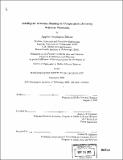Intelligent antenna sharing in cooperative diversity wireless networks
Author(s)
Bletsas, Aggelos Anastasiou, 1975-
DownloadFull printable version (13.77Mb)
Other Contributors
Massachusetts Institute of Technology. Dept. of Architecture. Program In Media Arts and Sciences
Advisor
Andrew B. Lippman.
Terms of use
Metadata
Show full item recordAbstract
Cooperative diversity has been recently proposed as a way to form virtual antenna arrays that provide dramatic gains in slow fading wireless environments. However, most of the proposed solutions require simultaneous relay transmissions at the same frequency bands, using distributed space-time coding algorithms. Careful design of distributed space-time coding for the relay channel is usually based on global knowledge of some network parameters or is usually left for future investigation, if there is more than one cooperative relay. We propose a novel scheme that eliminates the need for space-time coding and provides diversity gains on the order of the number of relays in the network. Our scheme first selects the best relay from a set of M available relays and then uses this "best" relay for cooperation between the source and the destination. Information theoretic analysis of outage probability shows that our scheme achieves the same diversity-multiplexing gain tradeoff as achieved by more complex protocols, where coordination and distributed space-time coding for M relay nodes is required. Additionally, the proposed scheme increases the outage and ergodic capacity, compared to non-cooperative communication with increasing number of participating relays, at the low SNR regime and under a total transmission power constraint. (cont.) Coordination among the participating relays is based on a novel timing protocol that exploits local measurements of the instantaneous channel conditions. The method is distributed and allows for fast selection of the best relay as compared to the channel coherence time. In addition, a methodology to evaluate relay selection performance for any kind of wireless channel statistics is provided. Other methods of network coordination, inspired by natural phenomena of decentralized time synchronization, are analyzed in theory and implemented in practice. It was possible to implement the proposed, virtual antenna formation technique in a custom network of single antenna, half-duplex radios.
Description
Thesis (Ph. D.)--Massachusetts Institute of Technology, School of Architecture and Planning, Program in Media Arts and Sciences, 2005. Includes bibliographical references (p. 143-152).
Date issued
2005Department
Program in Media Arts and Sciences (Massachusetts Institute of Technology)Publisher
Massachusetts Institute of Technology
Keywords
Architecture. Program In Media Arts and Sciences